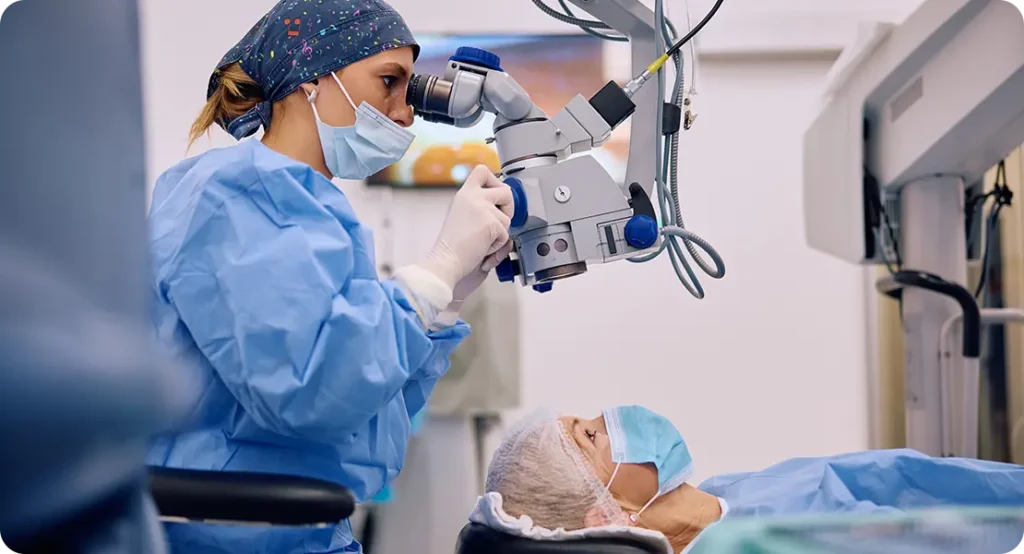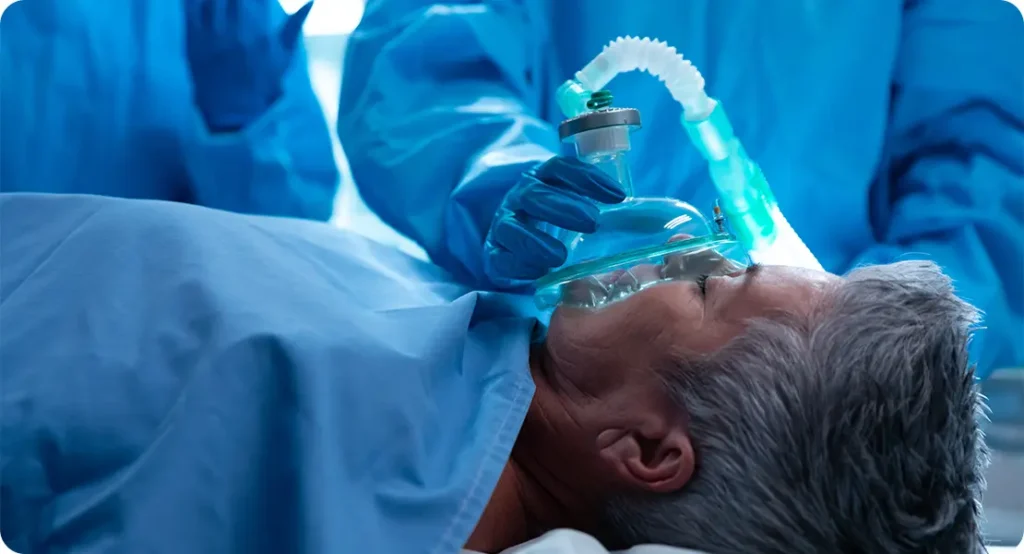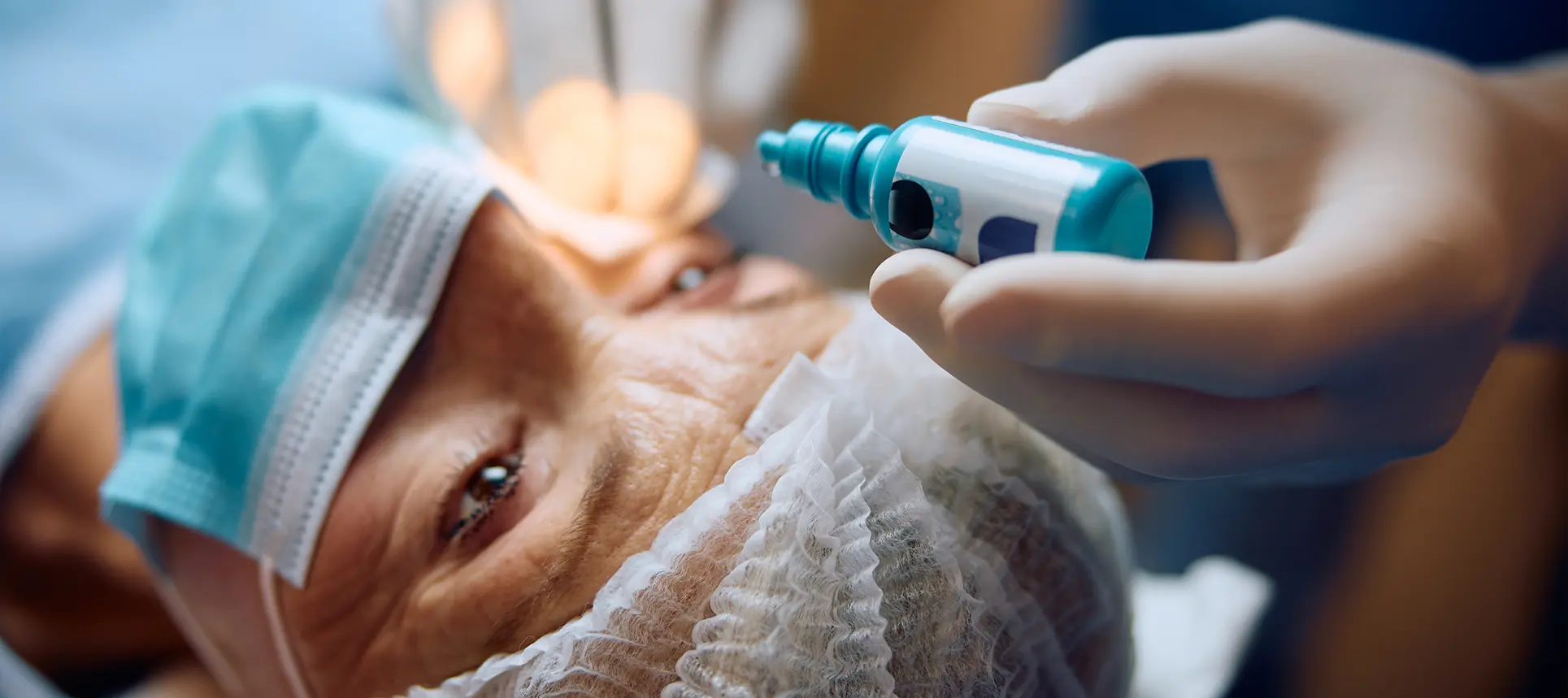If you’re preparing for cataract surgery, one of the biggest questions on your mind is likely: “Will it hurt?” It’s a fair question—and the good news is, thanks to modern anaesthetic techniques, the answer is no. But let’s break it down properly. In this guide, I’ll walk you through everything you need to know about cataract surgery anaesthesia. We’ll look at the types used, what you’ll feel during the procedure, how your safety is ensured, and even how the choice of anaesthetic might affect your recovery.
This isn’t just a dry medical overview—we’re going to have a proper chat about what it’s really like. So, whether you’re feeling nervous, curious, or just want to be fully informed, you’re in the right place.
What Is Anaesthesia, and Why Is It Important in Cataract Surgery?
Anaesthesia is what allows cataract surgery to be performed comfortably and safely. In essence, it’s a medical way to stop you from feeling pain or discomfort during the procedure. But when people hear the word “anaesthesia,” they often imagine being knocked out completely, like in major surgeries. That’s not usually the case for cataracts.
In fact, most cataract operations are done under local anaesthesia. That means you’re awake but pain-free. The anaesthetic is focused on numbing just your eye. It’s all about precision and control. No grogginess, no ventilators, no being wheeled into recovery with a dazed look. Just a calm, clear, and safe approach.
Why is this better? Because cataract surgery is a delicate but quick procedure. It doesn’t involve big cuts or deep tissue work. So, a targeted anaesthetic does the job nicely—without the risks that come with putting someone fully to sleep.
Types of Anaesthesia Used in Cataract Surgery
Now let’s go a bit deeper. There are several anaesthetic options for cataract surgery, and your surgeon will choose the one that’s best for your needs. But it’s useful to know what these options are.
1. Topical Anaesthesia
Topical anaesthesia is widely used in modern cataract surgery and is considered the go-to method for standard, uncomplicated cases. It involves the use of anaesthetic eye drops to numb the surface of the eye, specifically the cornea and conjunctiva. This type of anaesthesia does not affect the muscles around the eye, so the eye can still move during the procedure, but patients typically manage well with verbal guidance and a calm environment. Because it avoids needles entirely, it’s often preferred by both patients and clinicians for its ease of use and minimal invasiveness.
One of the major advantages of topical anaesthesia is the rapid onset of action. Within a few minutes of application, the surface of the eye becomes numb, allowing the surgeon to start the procedure almost immediately. There’s no need for a long prep time, which keeps the surgical workflow efficient. Additionally, the absence of injection-related trauma means there’s no bruising, swelling, or recovery time associated with local eye blocks. Patients can usually leave the clinic shortly after the operation with minimal downtime.
From a patient perspective, topical anaesthesia is generally well tolerated. Most people report a cool or slightly stinging sensation when the drops are applied, but this subsides quickly. Once numbness sets in, patients typically see only blurry shapes and lights during the surgery, without any pain. For those with anxiety about needles or injections near the eye, this technique provides immense reassurance and allows for a calmer surgical experience overall.
However, there are limitations. Because topical anaesthesia doesn’t immobilise the eye, patients must be able to stay still and follow instructions during the procedure. For individuals with tremors, communication difficulties, or high anxiety levels, other forms of anaesthesia may be more suitable. Moreover, if a case is likely to take longer than average—due to surgical complexity or underlying eye conditions—additional numbing or even a change in technique may be required to maintain comfort and control.

2. Sub-Tenon’s Anaesthesia
Sub-Tenon’s anaesthesia is a popular alternative to both topical drops and deeper injections, offering a safe and effective middle ground. The anaesthetic is delivered into the space between the sclera (white of the eye) and the Tenon’s capsule, a thin layer of tissue covering the eyeball. Rather than using a sharp needle, a blunt-tipped cannula is used to introduce the anaesthetic, which significantly reduces the risk of penetrating the globe or causing vascular injury. This approach has gained favour for its reliability and gentle technique.
Once administered, sub-Tenon’s anaesthesia provides both sensory and motor blockade. That means not only is the eye pain-free, but it also remains relatively still during surgery—an important consideration for the precision work involved in cataract removal. It allows the surgeon to operate without concern that the eye might suddenly move. This level of control can be particularly useful in patients who might struggle to stay completely still for 15 to 20 minutes, such as the elderly or those with mild cognitive impairment.
From the patient’s point of view, the experience is generally very comfortable. The eye may be numbed with gel beforehand, so even the pressure of the cannula being inserted is barely noticeable. Some patients describe a pushing or fullness sensation, but rarely do they report sharp pain. The overall experience tends to be smooth and reassuring, especially when the technique is carried out by experienced hands. Visual recovery after the surgery is not typically delayed by this method of anaesthesia.
This technique is especially useful for cases where topical anaesthesia may not provide sufficient coverage, but where a full peribulbar or retrobulbar block may be deemed too invasive. It’s also frequently used for patients who are particularly sensitive or who have had previous surgeries that make surface anaesthesia less effective. Overall, sub-Tenon’s anaesthesia strikes a careful balance between patient comfort, surgical precision, and procedural safety.
3. Peribulbar Anaesthesia
Peribulbar anaesthesia involves injecting anaesthetic into the area around the eye—specifically the extraconal space within the orbit. A fine needle is used to place the anaesthetic near the muscles and nerves that control both sensation and movement. Unlike topical or sub-Tenon’s anaesthesia, this technique achieves a deeper and more complete block. It’s particularly useful in situations where the surgeon requires a completely motionless eye or where the patient’s cooperation might be limited.
The procedure is a bit more involved than other forms of anaesthesia and typically takes a little longer to perform and to take effect. The eye is carefully cleaned and numbed with local anaesthetic on the surface before the needle is introduced. Once the injection is complete, the anaesthetic spreads gradually, producing both numbness and full akinesia (lack of movement) of the eye. A small pressure device or gentle massage is sometimes applied to help the anaesthetic distribute more evenly within the orbit.
Most patients tolerate peribulbar anaesthesia well, although the idea of a needle near the eye can understandably make some people anxious. Surgeons and anaesthetists are trained to communicate clearly and offer reassurance throughout the process. The injection itself is typically described as a pressure or squeezing sensation rather than painful. Post-procedure, the eyelid may appear slightly swollen or droopy for a short while, but this resolves quickly as the anaesthetic wears off.
There are some rare but potential risks, such as bruising, bleeding behind the eye (retrobulbar haemorrhage), or—in extremely rare cases—accidental injury to the globe. However, with proper technique and modern safety protocols, these risks are minimal. The main trade-off is between achieving a fully immobilised eye for a technically challenging surgery and the slightly higher invasiveness of the method. In selected cases, it remains an excellent and safe option.
4. General Anaesthesia
General anaesthesia is the least commonly used method for cataract surgery but remains a vital option in specific circumstances. It involves rendering the patient completely unconscious through a combination of intravenous medications and inhaled gases, with an anaesthetist carefully monitoring and controlling vital functions throughout the procedure. This option is typically reserved for individuals who cannot tolerate or cooperate with local anaesthesia due to medical, psychological, or developmental conditions.

The main advantage of general anaesthesia is that it removes the need for patient awareness or cooperation altogether. This can be particularly helpful in patients with severe anxiety, communication barriers, dementia, or certain physical disabilities. It allows the surgical team to perform the procedure without the additional complexity of managing an alert and potentially unsteady patient. It also ensures a calm and stress-free experience for those who would otherwise be deeply distressed by being awake during surgery.
However, general anaesthesia is not without its drawbacks. It requires more extensive preoperative assessment, fasting before surgery, and post-operative recovery time. The risks—while low in healthy individuals—are higher than those associated with local anaesthesia and include respiratory complications, cardiovascular strain, and delayed recovery in elderly patients. That’s why it is typically used only when absolutely necessary and after careful consideration by both the ophthalmologist and anaesthetist.
For those who do require general anaesthesia, the outcome of the cataract procedure itself is generally just as good as with other methods. The visual benefits remain the same, and the surgical process does not change—it’s the anaesthetic management that differs. Families and carers are usually involved in the decision, especially when cognitive or behavioural factors are involved. With the right precautions in place, general anaesthesia provides a safe and controlled route to successful cataract surgery in challenging scenarios.
Will I Be Awake During Cataract Surgery?
Yes, in most cases you’ll be awake. But before you panic—this doesn’t mean you’ll be aware of every detail. Your vision will be blurred due to the drops and drapes used, and you won’t feel pain.
Many people are surprised at how uneventful it feels. You’ll see bright lights, vague movements, maybe colours or shadows. You might hear your surgeon chatting calmly with the team. It’s very routine and often over in 10–15 minutes.
If you’re feeling anxious, sedation can be added. This is different from anaesthesia. Sedation is a mild relaxant—like a calming pill that takes the edge off your nerves. You’ll still be awake, but much more at ease.
The anaesthetist or nurse will stay close by to keep you comfortable. You’re never left alone or expected to “tough it out.”
What Happens Before the Anaesthetic Is Given?
Before the actual surgery, you’ll go through a short pre-operative process. This involves checking your vital signs, reviewing your medical history, and confirming which anaesthetic will be used.
If you’re having local anaesthesia, the process is quick. You’ll get the drops or injection a few minutes before the surgery starts. If you’re having general anaesthesia, you’ll likely fast beforehand and meet with an anaesthetist who’ll explain everything in detail.
You’ll be in a clean, calm environment. The team will guide you through each step. Nothing is rushed. If you have concerns or questions—this is the perfect time to ask.
What Does the Anaesthetic Feel Like?
Let’s be honest—no one loves having things done to their eyes. But the anaesthetic process is designed to be as gentle as possible.
With eye drops, you might feel a cool or slightly stingy sensation that fades within seconds. With injections, there’s often a feeling of pressure rather than sharp pain. And remember, your eye area can be numbed with a gel before the injection, so even that is quite tolerable.
After the anaesthetic takes effect, your eye will feel numb, heavy, and possibly frozen in place. That’s normal. You won’t be able to blink properly with the operated eye—but that’s managed by keeping the eye moist and protected during surgery.
Are There Any Risks Involved?
Every medical procedure comes with some level of risk, and anaesthesia is no different. But for cataract surgery, the risks are low—especially with topical or sub-Tenon’s anaesthesia.

Possible side effects include:
- Mild bruising around the eye from injections
- Temporary double vision or drooping eyelid
- Rarely, an allergic reaction to the anaesthetic drops
More serious complications like globe perforation (damage to the eyeball) or retrobulbar haemorrhage (bleeding behind the eye) are extremely rare and generally only associated with deep needle techniques like peribulbar blocks.
Your surgeon and anaesthetist will carefully assess your health to choose the safest method. Most people walk out of surgery with no issues at all.
How Long Does the Anaesthetic Last?
It depends on the type used. Topical drops wear off in about 30–60 minutes after surgery. Sub-Tenon’s and peribulbar injections can last a few hours. You might feel numb or heavy in the eye for a while, but sensation returns gradually and without any sudden pain.
If sedation was used, you may feel a bit drowsy or forgetful for a short time. It’s nothing like the deep grogginess of general anaesthesia, and most people are back to normal within a few hours.
What About After the Surgery?
Once the anaesthetic wears off, you may feel mild discomfort in the eye—often described as gritty or itchy, like a bit of sand under the eyelid. This is common and usually settles within a day or two.
You’ll be given drops to help with healing and to prevent infection. Painkillers are rarely needed, but if you feel sore, a simple paracetamol is usually enough.
It’s very rare for people to feel ongoing pain after cataract surgery. If you do, it’s important to get in touch with your surgeon right away.
Does the Type of Anaesthetic Affect Recovery?
Not significantly. Whether you’ve had drops, an injection, or full general anaesthesia, the visual recovery timeline is about the same. Most people see better within 24–48 hours.
However, with general anaesthesia, you may need more time to fully regain your energy, especially if you’re older or have other health conditions. That’s why local anaesthesia is often preferred—it’s safer, faster, and less disruptive.
How Do Doctors Decide Which Anaesthesia to Use?
It’s a joint decision between you, your surgeon, and sometimes an anaesthetist. They’ll take into account:
- Your general health
- Any past reactions to anaesthesia
- How anxious you are
- The complexity of your cataract
- Whether you’ve had eye surgery before
You should always feel part of the decision-making process. If you have a preference—say, you’d rather have drops than an injection—let your team know. They’ll do their best to accommodate you while ensuring your safety and surgical outcome.
Final Thoughts
Cataract surgery is one of the safest and most common procedures in the world, and modern anaesthesia is a big part of that. Whether you’re having a straightforward operation with just drops or a more complex case with a deeper block, the goal is always the same: to keep you pain-free, comfortable, and calm.
Don’t hesitate to ask questions. Don’t worry if you feel nervous. It’s completely normal. But trust this: anaesthesia has come a long way, and you’ll be looked after every step of the way.
If you’re concerned about cataract surgery or want to discuss anaesthetic options tailored to your needs, you’re very welcome to get in touch with us here at the London Cataract Centre. Our consultants are happy to walk you through everything face-to-face.
References
- Eke, T. and Thompson, J.R., 2007. The National Survey of Local Anaesthesia for Ocular Surgery II: Safety profiles of local anaesthesia techniques. Eye, 21(4), pp.490–495.
Available at: https://www.nature.com/articles/6702264 - Kumar, C.M. and Eke, T., 2012. Local anaesthesia for cataract surgery. British Journal of Anaesthesia, 109(1), pp.30–37.
- Royal College of Anaesthetists, 2023. Anaesthesia explained: Eye surgery.
- National Institute for Health and Care Excellence (NICE), 2017. Cataracts in adults: management (NG77).
- NHS Moorfields Eye Hospital, 2023. Having cataract surgery under local anaesthetic.

